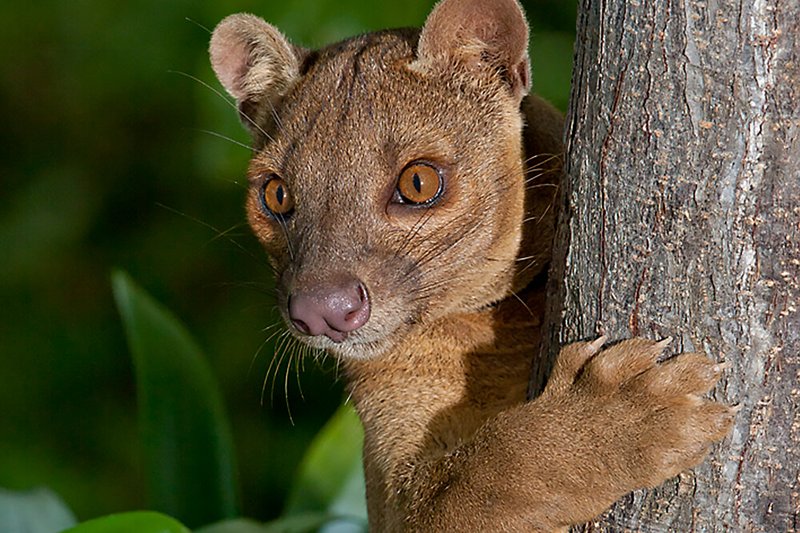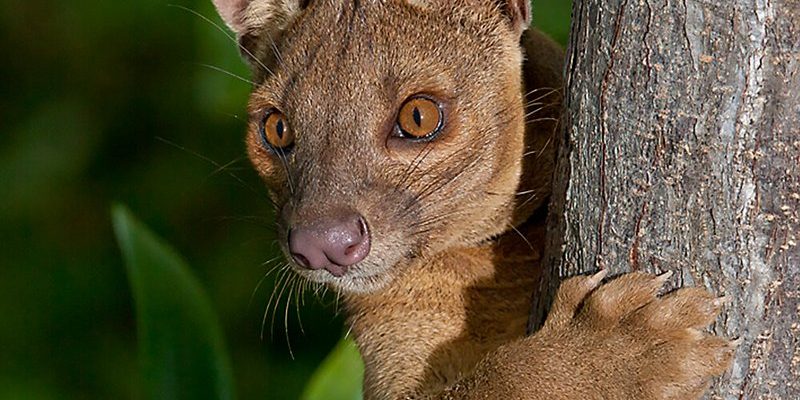
First off, imagine you’re wandering through a lush forest, surrounded by howler monkeys and colorful birds. Suddenly, you spot a fossa perched on a branch, its sleek body glistening in the sunlight. It looks like a mix between a cat and a small cougar, with a long tail for balance as it moves gracefully through the trees. Now, don’t panic! Encountering wildlife can be thrilling but also demands respect and caution. Here’s what you should keep in mind if you ever face a fossa in its natural habitat.
Understanding the Fossa: Nature’s Unique Predator
The fossa (*Cryptoprocta ferox*) is Madagascar’s largest carnivorous mammal. It resembles a small cougar but is more closely related to the mongoose family. With a slender body, sharp claws, and keen senses, the fossa is perfectly adapted to its forest environment.
Habitat and Behavior
Fossas primarily inhabit rainforests but can also be found in dry deciduous forests. They are excellent climbers and spend a lot of time in trees, which helps them hunt their main prey—lemurs. Their solitary nature means they prefer to live alone, apart from mating season, during which males may roam larger areas to find females.
Physical Characteristics
An adult fossa can measure up to six feet in length, including its long tail, which helps with balance. Their short, brown fur blends well with the forest, making them stealthy predators. A fossa’s sharp teeth and agile body allow it to tackle prey much larger than itself, proving that good things often come in unique packages.
Safety First: Keeping Your Distance
If you find yourself face to face with a fossa, the first thing to remember is to keep your distance. These animals, while fascinating, are wild. Just like meeting a bear or a lion, you need to respect their space.
Stay Calm and Observant
Instead of approaching the fossa, observe it from a safe distance. You might be tempted to take a photo, but it’s best to keep your camera at the ready and your feet still. Quick movements or loud noises could startle the fossa, which might lead to defensive behavior.
Avoid Eye Contact
While it’s human nature to want to lock eyes with an animal, direct eye contact can be interpreted as a threat. Instead, focus on the animal’s body language. If it appears agitated—fluffing up its fur or making noises—give it more space. Patience is key in wildlife encounters.
What to Do (and Not Do) When You Encounter One
Navigating a wild encounter can be daunting, but knowing what actions to take (or avoid) can make all the difference. Here’s a simple guide to keep you safe.
What to Do:
- Back Away Slowly: If the fossa comes closer, don’t panic. Move away calmly while keeping your eyes on the animal.
- Make Your Presence Known: If the fossa seems curious, you can gently clap your hands or make a low noise. This may encourage it to leave the area.
- Secure Your Belongings: Ensure that any food or shiny objects are safely stored away, as these can attract the fossa.
What Not to Do:
- Don’t Approach: Getting too close can be dangerous for you and the animal.
- Avoid Feeding: Feeding wildlife can lead to dependence and may encourage them to come closer to human populations.
- Don’t Corner It: Make sure you don’t trap the fossa. Always allow it an escape route.
Why Respecting Wildlife Matters
You might be wondering, why does it really matter how we treat animals like the fossa? The answer lies in the bigger picture of conservation and ecological balance. Madagascar is home to many unique species, and the fossa plays a vital role as a top predator.
Conservation Impact
By ensuring that we respect the fossa and its habitat, we help protect the delicate balance of the ecosystem. When humans encroach on wildlife habitats without care, it can lead to diminished populations and even extinction. The fossa helps control lemur populations, which keeps the ecosystem healthy.
Fostering a Respectful Attitude
When people learn to appreciate and respect wildlife, it fosters a sense of responsibility towards environmental conservation. Educating others about safe wildlife encounters ensures that future generations can witness the beauty of animals like the fossa.
Capturing the Moment: Ethical Wildlife Photography
So, you’ve seen a fossa and want to remember the experience. Capturing wildlife through photography can be rewarding, but it comes with its own set of ethical considerations.
Respecting Their Space
Always use a telephoto lens if you plan to take photos. This allows you to capture the moment without getting too close. The goal is to document the fossa without intruding on its natural behavior or causing stress.
Share Your Experience
Consider sharing your photos and experiences on social media or with wildlife organizations. This raises awareness about the fossa and its importance while encouraging others to approach wildlife with the same respect you did.
Final Thoughts: Embrace the Wild, Respect the Fossa
Encountering a fossa in the wild can be one of those unforgettable moments that make you appreciate nature’s wonders. By knowing how to act when you see one—keeping your distance, respecting their space, and understanding their role in the ecosystem—you can turn a potential scare into a thrilling encounter with a fascinating creature.
Remember, wildlife thrives when we choose to be mindful explorers rather than reckless tourists. Next time you find yourself on the trails of Madagascar, you’ll be better prepared to embrace the wild in all its glory.

